
EIV 1 - 25 * 10 mm - SOLD
Price: 700 usd
|
INDUS BEADS FROM 'GREATER INDIA'
Most of the beads featured here hail from Balochistan,
currently part of Pakistan. Nevertheless, they are not
categorized as 'Pakistanus' Valley beads. Instead, they
are rightly referred to as Indus beads, and for a
compelling reason.
These beads serve as historical compasses, pointing us
back to a period when a 'Greater India', at the zenith
of the Indus civilization, sprawled across an
astonishing 1.5 million square kilometers! This expanse
even encompassed Kabul during the later era of the great
Mauryan Empire. Hence, it's important to acknowledge
that the roots of India's magnificent ancient culture
stretch well beyond the confines of the country's
current geographical borders.
The following treasures you are about to explore are the
oldest art beads known to humanity, not just in Asia as
per Peter Francis' writings, but globally. They are
silent testament to the deep and diverse heritage of
this part of the world, bearing witness to an era of
unmatched creativity and craftsmanship.
|
The beads in
my collection
are now for sale
Inquire
through bead ID
for price
|
|
|
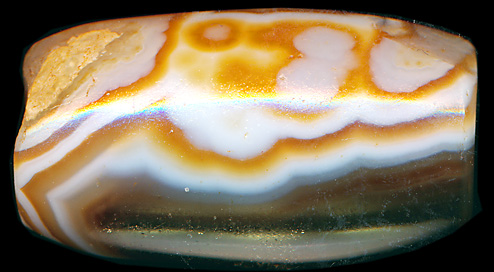
EIV 2 -
Price: 900 usd
|
Ancient Beads as
Masterpieces of Art
The allure of these ancient beads lies not just in
their age or rarity, but also in their artistic quality.
Much like modern paintings, they enchant us
with their abstract patterns and brilliant color
schemes. They stand as evidence that abstraction, the
touchstone of contemporary art, was present even at the
dawn of human civilization. It's no surprise that modern
artists like Picasso found inspiration in the primal
forms of ancient artifacts.
The Microcosm of Patterns and Colors
Yet, these beads are akin to miniature
paintings—treasures that encapsulate an entire world
within their petite form. If you are fortunate enough to
possess an ancient Indus bead, I encourage you to keep a
high-quality loupe close at hand. Through its lens, you
will be transported into a microcosm of intricate
patterns and vibrant colors, a world that bears the
imprint of a civilization long past.
The Indus people remain shrouded in mystery, their
scripts still undeciphered, their lives and thoughts
left largely to our speculation. But amidst this
uncertainty, at least two commonalities bridge the gulf
of millennia between us: an appreciation for beauty and
an intrigue for the rare and distinctive.
|
|
|

EIV
3
- 55 * 15 m
Price: 1.300 usd
|
Quantifying Beads &
People at the Dawn of Civilizations
When the Indus civilization began to flourish around
3000 BC,
the entire global population was roughly around 14 million. It's
estimated that between 3 to 5 million of these individuals were
fortunate enough to call the fertile expanse
of the Indus Valley their home. Given these numbers, one
can begin to grasp just how limited the number of
ancient artifacts from this time period must be. Indus
beads are, as a result, incredibly scarce.
´
Fast forward to the era of the Mauryan Empire under
Ashoka
around 250 BC,
and the world's population had skyrocketed almost
tenfold to approximately 130 million. The Mauryan
Empire, being the most populous of the time, boasted
estimated 50 million inhabitants!
Concurrently, the production of beads experienced a
significant boom.
As the populous grew and civilization matured, the craft
of bead making was honed and expanded, resulting in a more
abundant presence of these cultural artifacts. However, even
within this period of increased
production, the sheer antiquity and survival of these
beads through millennia make them are truly a rarity.
|
|
|

EIV 4 -
63 * 15
mm
Price: 1.600 usd
|
Understanding the Rarity of Ancient Authenticity
By this point, one can begin to appreciate just
how rare and precious ancient beads truly are in our
world. This scarcity becomes even more pronounced when
we narrow our focus to fossilized beads - a minuscule
subset within the already limited collection of ancient
beads. You can explore a dedicated display of these
Ancient Fossil Beads
in a separate section here.
I estimate that the quantity of authentic ancient Indus
beads in circulation today is more than ten times less
than that of beads from the later classical period. This
disparity is further compounded by the evolving societal
significance of beads throughout history. Initially,
beads were predominantly worn by the upper classes,
symbolizing their elite status. As time progressed,
beads transformed into a more common commodity,
extending their reach to the emergent trading middle
class and the sizable segment of Buddhist monks.
In this context, Indus beads deviate from the prevalent
trajectory towards mass production of identical items. They are
not just transactional tools or "money
beads", but occupy a distinctive category of their own.
Their aesthetic variety, elaborate design, and meticulous
workmanship mark them as art pieces, celebrated for their
diversity. In fact, many of them possess such unique beauty that
stringing them together in a single chain might result in a
conflicting or nullifying effect on their individual appeal.
|
|
|
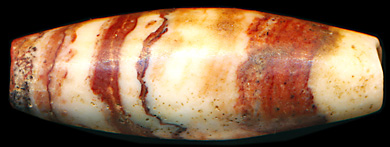
EIV 5 - 23 * 8,5 mm
Price: 700 usd
|
Chasing the Unique:
Rare Stones of Many Colors, Shapes, and Forms
The Indus people, right from the inception of their
civilization, were deeply invested in procuring rare and
exotic stones for crafting their beads. These gems came
in a vast array of colors, shapes, and sizes, each
meticulously selected for its distinctive
characteristics.
As the skills of bead-making advanced and societal
stratification deepened, merely possessing a perfectly
crafted bead no longer sufficed. The aesthetic merit of
a bead, while important, began to share the stage with
the rareness of the material from which it was
fashioned. Owning a bead carved from a unique and
elusive stone became a symbol of distinction and a
testament to one's status.
|
|
|
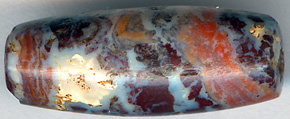
EIV 6 -
24 * 9 mm
Price: 700 usd
|
In this pursuit of exclusivity, the quest for unique and
rare stones grew increasingly vital. The scarcity of the
material used not only magnified the allure of these
beads but might also have elevated their owners' social standing.
This accounts for the captivating diversity of Indus
beads, which manifest in an array of shapes, materials, and
colors, a stark contrast to the monotonous uniformity of DZI-beads.
Each bead served a distinct purpose: to distinguish its wearer,
to elevate their status. The absence of uniformity in the design
and materials used for these 'stand out and above' beads subtly
illuminates the peculiar stage of class diversification during
this period.
|
|
|
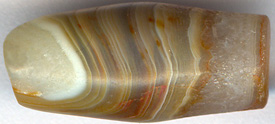
EIV 7 -
23
* 10 mm
Price: 700 usd
|
Both the Egyptian and
Indus Valley civilizations were borne of river cultures,
yet their societal organization appears to have stark
contrasts. Unlike the contemporaneous Egyptian society,
which exhibited a rigid, uniform and vertical system of
social stratification, the Indus Valley society seemed
to embrace a more fluid social hierarchy. Status markers
within the Indus community were likely to have been more
personal and individualistic rather than standardized.
This relative absence of rigidity, this variance from
uniformity, is mirrored in the diversity and singularity
of their beads. It is tempting here to view each bead as
a unique testament to its wearer's status and identity,
reflecting an inherent individuality and personal
expression not commonly found in strictly stratified
societies.
|
|
|
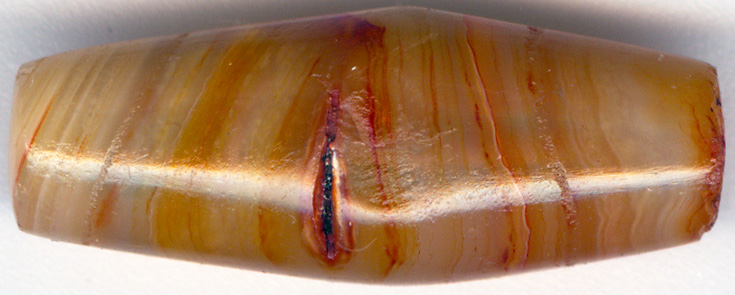
EIV 8
- 30,5 * 11 mm
Price: 700 usd
|
Indus Individuality
The remarkable diversity of Indus beads—their shapes, materials,
and hues—forms a striking juxtaposition against the homogeneous
uniformity of beads from
subsequent epochs. Each bead served a unique purpose—to
emphasize its possessor's individuality, making them distinct.
This particular aspect of Indus beads exhibits a fascinating
parallel with our current appreciation of individualism. In our
modern Western society, emphasis is placed on personal
uniqueness and self-expression. Just as every Indus bead is
unique and designed to symbolize its owner's distinctness, so
too do we, in our modern society, value our unique
characteristics and experiences. We express ourselves through
our fashion, art, opinions, and even our social media profiles.
We cherish our distinctiveness and constantly seek to establish
our individual identity.
Just like the Indus beads, we strive to assert our uniqueness in
a sea of uniformity. The non-conformity that these beads
symbolize echoes our own contemporary pursuit of individuality.
This can serve as a reminder that the drive for individual
expression is an archetypical human trait, one that transcends
cultures and epochs, manifesting itself in the intricate
artistry of the ancient Indus bead or the personal branding of a
modern social media profile.
|
|
|

EIV 9 -
24
* 8 mm
Price: 700 usd
|
I remember the future
Research has demonstrated that the same areas of our
brain are responsible for both remembering our past and
envisioning our future. As a trade-off, our
recollections of distant events may become hazy and
unreliable, enabling us to construct possible future
scenarios. So permit me to gaze into the future through
the lens of the Indus:
In the West's not-too-distant future, I anticipate a
subtle shift away from traditional displays of social
prestige through uniform symbols of wealth, such as gold
or luxury brands. The focus will instead be on
individual style and unique self-expression—what one
might call the projection of a personalized 'avatar.'
I envision a
world where traditional status symbols are gradually losing
their appeal to the more advanced and discerning individuals.
The new
trendsetters seek uniqueness, individuality, and authenticity
over conventional symbols of wealth or status.
|
|
|

VEIV 10
- 30,5 * 7 mm
Price: 900 usd
|
Indeed, as highlighted in the "My
Favorite ancient beads"
section, there was still room for the creation and use of beads
as social signifiers and pieces of jewelry in later periods.
Unique, handcrafted beads that reflected individuality and
status were still made and treasured in the
Indian classical age.
However, these artistic,
individualistic beads coexisted with a far more prevalent
mainstream of uniform beads, notably exemplified by
the sulemani and DZI
beads.
These uniform beads, produced en masse, were more accessible and
widespread. While they may have lacked the unique
characteristics of their handcrafted counterparts, they played
an essential role in everyday transactions and social
interactions, serving as a form of currency or as commonplace
adornments.
This dual existence of beads - as mass-produced commodities and
as unique pieces of art - mirrors the complex dynamics of
ancient societies, reflecting both the utilitarian needs of
everyday life and the human desire for artistic expression and
individual distinction.
|
|
|
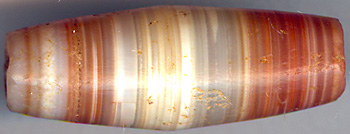
EIV 11 -
28
* 10,5 mm
Price: 700 usd
|
|
THE RAREST
OF THE RARE - LONG SLENDER BICONE INDUS BEADS
Featured on this page is my collection of ancient, slender,
bicone Indus Valley beads. An intriguing observation about these
beads is the elliptical shape they exhibit, tapering from the
ends towards the center. As James W. Lankton discusses in his
book "A Bead Timeline," these unique beads had a relatively
brief production period, particularly post 2450 BCE.

Emblems of prestige: Elongated and slender in durable
materials
Creating elongated, slender bicone agate beads was an arduous
and time-consuming task. The crafting of just one of these beads
could often demand more than two weeks of meticulous labor! In
terms of social hierarchy, the emergence of this type of bead
reflected the increasing need for conspicuous displays of power
and status. This dovetailed with the evolution of
bead making technology
among specialized artisans who managed everything from sourcing
materials to final bead production. In addition, there must have
been a well-defined, and most likely privileged, cadre of
merchants.
The ultra-rare drilling material: Ernestite
Drilling such long, precise holes was made possible by using a
cylindrical drill made from an extremely rare type of
metamorphic rock called Ernestite (named after the archaeologist
Ernest Mackey). When the supply of Ernestite was depleted, the
production of these extraordinary beads also ceased. The
scarcity of Ernestite, along with the painstaking effort and
skill required to create these beads, further contributes to
their status as among the rarest of all Indus Valley artifacts.
|
|
|

EIV
- 44 * 12 mm
Price: 900 usd
|
Pondering on the
presence of
long, bicone beads made of softer materials such as
limestone prompts interesting insights into the social dynamics
of the Indus civilization. From a durability perspective, it
indeed seems counterintuitive to craft beads from such
materials. However, a likely explanation is that these were
mass-produced to serve as an affordable alternative for the
lower social strata, mirroring the status-displaying beads of
the wealthy.
Archaeologists have unearthed similar imitations made from terra
cotta in Nausharo, suggesting a widespread practice of creating
replicas using more accessible materials. These "knock-offs,"
made from sandstone or other less durable materials, could be
considered the ancient equivalents of modern-day counterfeit
Rolex watches. In today's world, there might be more of these
imitation watches than genuine Rolexes.
|
|
|

EIV 21
- 44 * 12,5 mm - Sandstone
Price: 900 usd
|
However, a curious consideration for the future arises: given
their lower quality and durability, these imitations might
become much rarer than the originals over a millennium from now.
This amusing and insightful idea struck me as I was admiring the
fragile yet perfectly crafted banded sandstone bead displayed above.
Despite its vulnerability, it stands as a testament to the human
inclination towards beauty and social recognition, transcending
constraints of material and class.
Multi
colored Beads
The Indus
bead makers had a clear fascination with incorporating a
diversity of colors within a single bead, a trait vividly
demonstrated in the agate bead showcased below. This penchant
for a multicolored aesthetic is further evident in the
collection of
Late Indus Valley beads.
|
|
|

EIV 27 -
27 * 7,5
mm
Price: 1000 usd
|
These people from the Indus Valley honed their skills to become
exceptional masters in the art of bead making. In fact, I would
boldly posit that prior to the invention of the diamond drill
around 500 B.C., the inhabitants of the Indus civilization were
the leading exporters of beads to neighboring civilizations
within the same fortunate geographical band,
the
lucky latitude,
sharing their remarkable craft with other societies of the time.
Their dedication to their craft and keen eye for aesthetic
complexity distinguished them as unparalleled artisans in the
realm of beadwork.
THE INDUS
VALLEY CIVLIZATION
An Enigma Shrouded by the Abrasives of Time
Outshining its contemporaries, the
river civilizations,
of
Egypt
in the Nile Valley and
Mesopotamia
between the Tigris and Euphrates, the Indus Valley civilization
was a leviathan in comparison. At its zenith, the expanse of the
Indus Valley civilization is estimated to have stretched across
a staggering one million square kilometers, making it larger
than the whole of Western Europe.
|
|
|
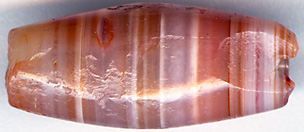
EIV 100
-
25 * 10 mm
Price: 500 usd
|
A Riverine Renaissance
The people of the Indus Valley, unlike their successors in the
Vedic Age, did not have the technology to dig wells or pump
water from these wells using stone pulley wheels
wheels with strapped wooden pails.
You need iron tools, like shovels to dig a well. Rather, their forte lay in harnessing floodwaters for irrigation
purposes by creating intricate networks of channels. As a
result, their settlements were predominantly located in river
plains and areas in close proximity to rivers.
|
|
|
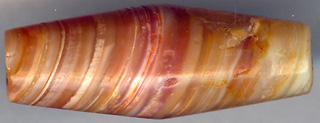
EIV 97 -
26,5
* 9,5 mm
Price: 700 usd
|
This reliance on rivers for agriculture likely fueled the
prodigious expansion of their civilization. Forced to follow the
course of rivers and avoid cultivating areas too far from the
reach of flood irrigation, the Indus people transformed barren
deserts into verdant gardens. This extraordinary collective
achievement of river management is nothing short of an
architectural marvel.
|
|
|
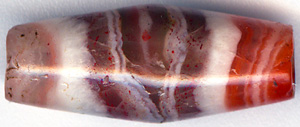
EIV
98
-
25 * 10 mm
Price: 700 usd
|
The Egyptians might have been known for their grand pyramids,
but the legacy of the Indus people was of a different kind - the
monumental water reservoirs and channels they constructed. The
scale of this feat is so immense that it remains unrivaled to
this day when viewed through historically calibrated lenses.
|
|
|

EIV 101
-
19 * 10 mm
Price: 500 usd
|
The
River and the Rise of Commerce
The vast geographical extent of the Indus civilization was the
cornerstone for its prosperous long-distance trade network,
propelling it to reach production levels that were almost
industrial in nature. Acting as the lifeline of the 'empire',
waterways seamlessly bound together disparate regions.
In a natural progression, the Indus people morphed into adept
sailors, operating large fleets of ships that plied the vast
river plains, coastal areas, and neighboring regions. Their
maritime prowess was a critical factor that allowed their
civilization to bloom in these diverse regions.
|
|
|

EIV 102 -
19,5
* 6,5 mm
Price: 900 usd
|
The Indus Valley civilization held extensive trade links with
Mesopotamia,
exporting a myriad of goods such as cotton cloth, intricately
designed stone beads, ceramics, and copper and bronze ware. The
demand for their products was so significant that they tailored
their designs to meet the tastes and preferences of their
western trade partners.
Notably, according to archaeologist
Mark Kenoyer,
the impact and influence of the Indus Valley civilization
extended far beyond the mere trade of goods. In fact, there was
a settlement in Mesopotamia comprised of craftsmen from the
Indus region, which is a striking testimony to the cultural
exchange and intermingling that occurred between these ancient
civilizations.
|
|
|
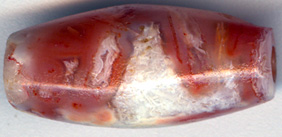
EIV
99
-
23 * 10 * 9 mm
Price: 700 usd
|
Remarkable
Urban Planning
Catering to a population between 3 to 5 million people, which
comprised about a third of the world's population at that time, the
Indus Valley civilization required innovative solutions for
habitation. This led to the advent of some of the earliest known
urban centers. These cities were products of meticulous and
advanced urban planning, the likes of which were perhaps driven
by the indispensable need for water management in order to
sustain such large populations.
The Indus civilization showcased an extraordinary expertise in
engineering, manifesting in their advanced water management
systems. These systems comprised meticulously laid out
waterways, drainage, and sewage facilities, all constructed with
uniformly sized bricks. Such a high degree of standardization
reveals an exceptional degree of planning and organization.
Yet intriguingly, this fondness for uniformity in their urban
infrastructure sharply contrasts with their apparent fascination
for uniquely crafted beads. These beads, varying in shape, size,
color, and material, stood as individual works of art, each
distinctive and diverse. This seeming dichotomy—strict
standardization in civic planning alongside a celebration of
uniqueness in bead craftsmanship—demonstrates the
multidimensional nature of the Indus civilization. It perhaps
points towards a nuanced societal ethos that balanced the
stability of conformity in public infrastructure with the
creative expression of individuality in personal adornments.
|
|
|

EIV 28 -
58 * 14
mm
This is not a bead, but an
ancient mystery
Indus talisman made in jasper and copper.
Price: 1.200 usd
|
Their cities were
not just functional but also comfortable. The orientation of the
houses was carefully planned to harness wind currents, providing
a natural form of air conditioning. The urban layout showcased
clear understanding of geometry, with streets, multi-story
houses, and public structures like baths set in relation to each
other using perpendicular alignment.
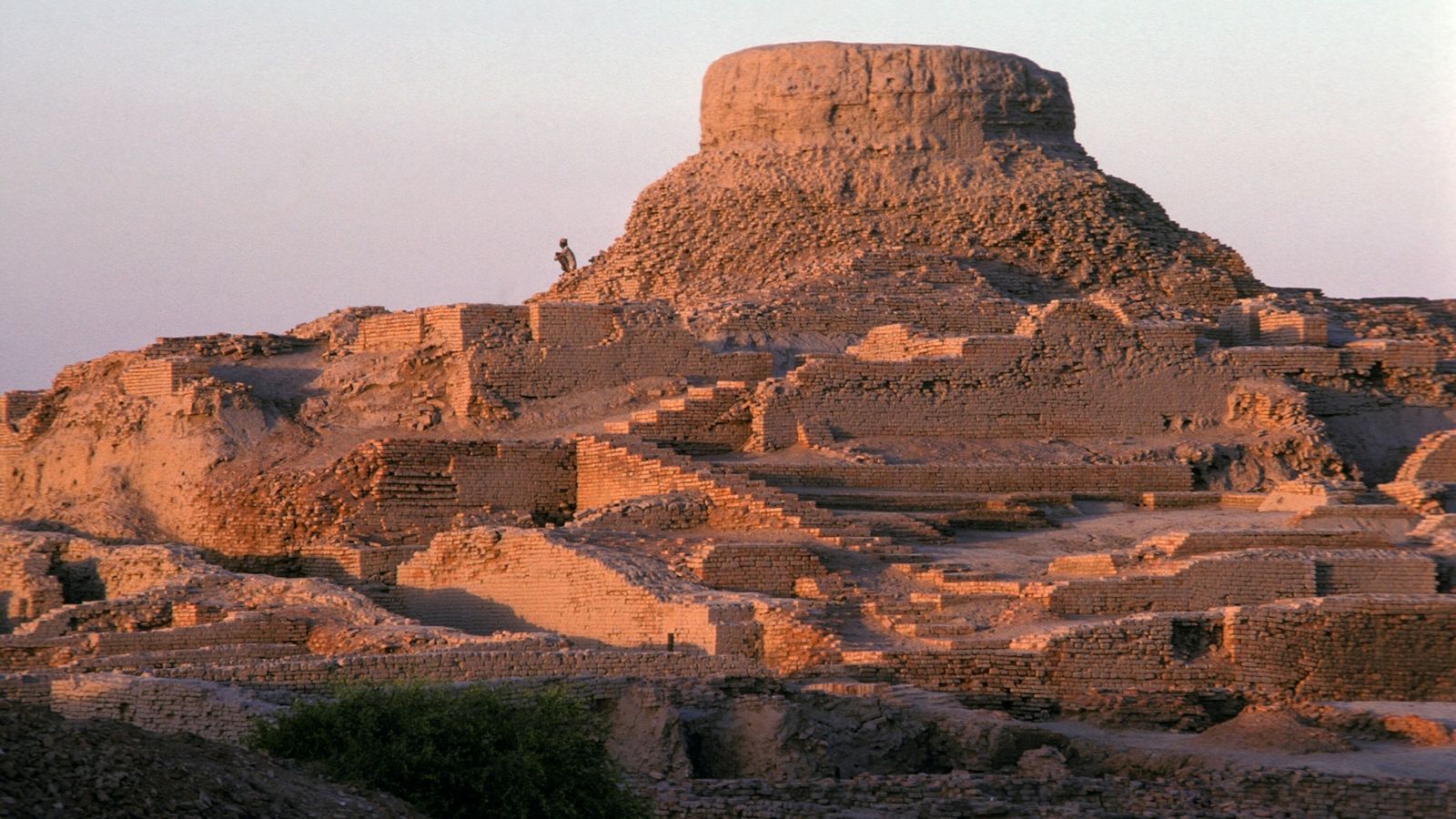
Mohenjo - Daro
Interestingly, their urban layout was based on modular design
principles. Structures in the city could be divided by the
standard measure of one of their building bricks, revealing an
intriguing layer of
their urban planning strategy. This is an
astonishing testament to the Indus civilization's sophisticated
understanding of mathematical principles, measurement, and
architectural design.
|
|
|

EIV 103 -
21,5
* 7 mm
Price: 450 usd
|
Intriguing
Urban Ecosystems
The mega-cities of the Indus Valley civilization necessitated a
substantial inflow of food resources and an equivalent outflow
of goods and commodities. This dynamic was likely maintained
through regulated and well-orchestrated commerce. The massive
walls enclosing the cities were not constructed for the purpose
of military defense, as is often assumed with ancient walled
cities. Instead, these structures served as a means of
controlling trade regulation.
Remarkably, archaeological findings provide
no evidence of warfare within the civilization's long
history, suggesting that the Indus people lived peacefully for
over 2000 years. This observation points towards sophisticated
social systems and conflict resolution mechanisms that were
capable of maintaining harmony in such densely populated urban
centers. The fact that such a large civilization could thrive
for so long without the shadow of conflict or warfare is truly
astounding and serves as a testament to the advanced societal
structure of the Indus Valley civilization.
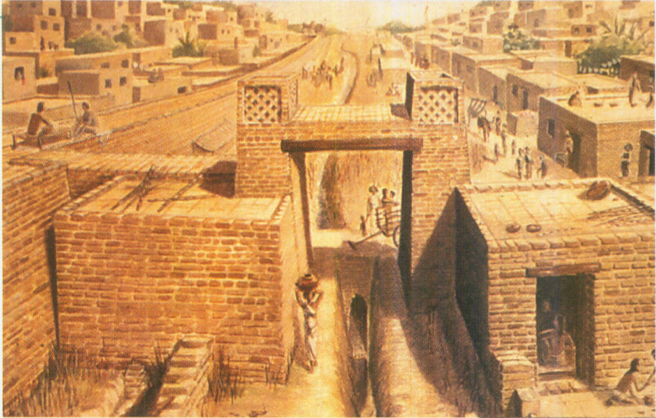
Computerized reconstruction of a typical Indus city
This peaceful coexistence has led scholars to infer that the
Indus Valley civilization had strong norms of cooperative
behavior, societal regulations, and perhaps even forms of
negotiation or diplomacy that helped prevent conflicts from
escalating into violent confrontations. They might have
developed systems of justice or dispute resolution that diffused
tension and maintained the social fabric of their complex
society. The details of these mechanisms, unfortunately, remain
a mystery, since their script remains undeciphered.
|
|
|

EIV 104 -
19,5
* 8 mm
Price: 650 usd
|
Greater India was the
bead maker to the world
Indeed, the
connection between the Indus Valley civilization and beads is
profound. The flourishing Indus Valley civilization, also made a significant contribution
to the world through their unparalleled craftsmanship in bead
making. As Peter Francis put it:
More than any other land India
has been "bead maker to the world."
The Beads of India -
Peter Francis
The ancient Indus artisans, through their meticulous and skilled
craftsmanship, produced an astonishing variety of beads from a
myriad of materials including, but not limited to, stone, shell,
and ceramic. The vast and diverse range of beads from this era
is a testament to their ingenuity and skill. The beads also
served as an essential commodity in their expansive trade
networks, leading to their spread far and wide across different
cultures and civilizations.
In fact, the influence of Indus Valley bead-making was so
profound that the majority of stone beads older than 1000 BCE
are believed to have been crafted in the Greater India region,
by Indian artisans or by craftspeople who learned the trade from
these experts. This historical fact is an integral part of
Indian cultural heritage. However, it's surprising that this
significant contribution of ancient India to the world of
bead-making is not widely recognized or celebrated within India
itself.
This rich history provides an interesting perspective on the
remarkable cultural and technological achievements of the Indus
Valley civilization and sheds light on its influential role in
the global spread and development of bead craftsmanship.
|
|
|
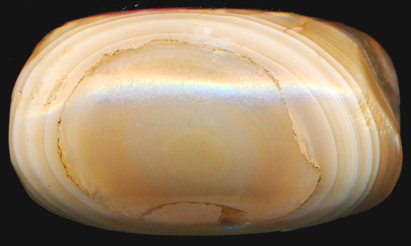
EIV 105 -
Price: 900 usd
|
Great care has been taken in cutting many of these
stones so as to get special effects from the natural
structure of the stone, white or colored bands being
arranged to form 'eyes' , 'zones' or chevrons, all of
which may have had special meanings. (Beads
from Taxilla,
Horace Beck - p.8)
|
THE INDUS NARRATIVE
Dwelling upon the
societal tapestry of the Indus Valley Civilization, the question
that lingers is: What guided their collective conscience? What
were the fundamental ideas that shaped their society and
worldview?
The question of the societal glue that held them together is
intriguing. What constituted their core narratives and how did
they perceive their world?
Based on what they left behind, we can confidently assert that
they cherished beauty and uniqueness. This is eloquently
expressed through the dazzling array of their beads, each more
unique and captivating than the last. Unlike cultures that
encouraged uniformity, the Indus Valley Civilization seemed to
celebrate diversity.
Contrast this with the DZI beads, the prized possessions of
ancient Tibetan culture. Unlike the daring individuality
expressed in the Indus beads, the DZI beads, much like the
society that cherished them, exhibited a sense of uniformity and
conformity.
Returning to the Indus Valley Civilization, it's clear that the
establishment and maintenance of such a large-scale civilization
in an era that predates much of recorded history would have
necessitated a resilient social fabric. A society capable of
planning and constructing immense cities, nourishing a vast
population, and producing a thriving economy without the marks
of violence or warfare points towards a strong societal
cohesiveness. Perhaps, the richness and variety in their bead
art is a reflection of the underlying strength of their societal
bond and mutual respect for individuality.
|
|
|
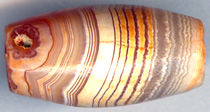
EIV 106
-
17 * 8,5 mm
Price: 700 usd
|
The elephants of King Porus
In India,
particularly for those who have resided there for an extended
period, the potency of oral storytelling traditions is palpable.
This stands in stark contrast to the waning traditions of the
West. I recall an incident in Punjab where a local, during a
dispute, belittled another by comparing him to the elephants of
King
Parvateshwar (Porus)
Intrigued,
I queried him about the essence of this unusual comparison. He
enlightened me that within the Punjab region, it's quite typical
to compare a man who is all show and no substance to King
Porus's elephants. These elephants, despite their impressive
trumpeting, collapsed under pressure, a metaphor drawn from
their historical confrontation with Alexander's army. This
phrase, to the best of my knowledge, isn't from any literary
source. It has survived through the ages, handed down orally
since the time of Alexander, and continues to remain a tiny but vibrant
part of the regional identity.
|
|
|

EIV 107 - 24 * 8 mm
Price: 800 usd
|
The Indian time machine
India presents a fascinating blend of
tradition and modernity. Unlike other cultures, Indians possess
a remarkable ability to straddle both the modern and the
traditional simultaneously. Indian women continue to don saris
and bangles, symbols of age-old customs, even as they
enthusiastically engage in contemporary practices. They revere
their ancient mythological events with the same fervor as they
do their beloved sport of cricket.
The influence of the West is palpable, yet it's refracted
through a distinctively Indian lens. The quintessential American
fast-food, McDonald's, has been warmly embraced but only after
transforming the classic burger into a dish distinctly more
Indian in taste.
Middle-class Indians might have televisions in every room, but
the programming they consume is predominantly homegrown. So,
even as India embraces the conveniences of modern life, it does
so without compromising its deep-rooted cultural identity. It's
like stepping into a time machine, where the past and the
present coexist harmoniously, each enriching the other,
embodying the richness and diversity of the Indian cultural
tapestry.
|
|
|
V

EIV
13 -
44 * 12 mm
Price: 1.000 usd
|
Many of them have never heard of the Beatles. They have
their Bollywood heroes and heroines. I once met a
Nobel-winning Indian scientist, who claimed to be an
incarnation of a Danish man. This man is reflecting a
strange fact about India: that one historical period
does not erase the ones that were there before, even
more so when it comes to the soul of the people. Not
even the Muslem invasion managed to do that. In
contemporary India find a myriad of religious traditions
from almost every historical period.
|
|
|

EIV
35 -
27
* 6,5
mm
Price: 900 usd
|
This bead has like many of the
beads from this collection been colored by chemicals in
the earth.
However this in some cases create
even more beautiful beads. |
In India,
the panorama of human experience unfolds in countless ways. Some
engage in Vedic fire rituals, keeping alive practices dating
back thousands of years, while others choose to renounce worldly
pleasures, embodying the spirit of the ancient
Rishis.
Great throngs congregate to offer their devotions to deities
like Krishna, an affirmation of enduring religious traditions.
The list of examples is seemingly endless.
Adding to this rich mosaic is the social stratification fostered
by the caste system. While it contributes to a sense of
fragmentation, paradoxically, it also serves to safeguard and
magnify inherited traditions. Each caste preserves its identity
through the uniqueness of its rituals and practices, thus
becoming custodians of distinctive cultural threads within the
larger tapestry.
India, in essence, is a living time machine. It embraces the
relentless march of modernity while ensuring that the echoes of
its past continue to resonate in the present.
|
|
|
|

Indian
tribal woman - note her ancient tatoo
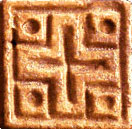

Indus Valley seal & ancient etched bead
Albert
Einstein once said, "Imagination is more powerful than
knowledge." I believe this aphorism provides a helpful
perspective when seeking to understand the social
cohesion of the Indus Valley civilization. While we
await the deciphering of the Indus script, clues to
their collective identity and shared values may be
discerned in the living tapestry of modern-day India.
These clues are not confined to dusty tomes or scholarly
treatises but are vibrantly present in the everyday
lives of the people.
Take, for instance, the photograph I took in New Delhi's
bustling Main Bazaar. It features a tribal woman with a
symbol tattooed on her throat. This symbol isn't a
recent cultural innovation but a motif that appears on
Indus Valley seals and ancient beads.
|
|
|
LARGE INDUS BEADS

EIV 36
- 93 * 12,5 mm
Price: 1500 usd
|
Despite the passage of millennia, echoes of the Indus
civilization endure within the cultural memory and
practices of contemporary India. The narratives,
symbols, and traditions of that ancient society continue
to influence and shape the identity of India's diverse
populations. The story of the Indus civilization, it
seems, is not merely a tale of the distant past, but a
living narrative still unfolding in the present.
|
|
|

EIV 37
- 65 * 25 * 21,5 mm
SOLD
|
|
|

EIV 38 -
62
* 14 mm
Price: 1.500 usd
|
Given the vibrant and enduring cultural memory in India,
I intuit that it still retains vital strands of civilizational
DNA that could help address some of the global challenges we
face today. These strands of cultural DNA carry valuable
insights about social cohesion forces, insights we need to
rediscover and apply in societies that are increasingly
fracturing under the weight of selfishness and greed.
This ancient social glue, however, will not be revived through
mere observation or intellectual study. It requires a fertile
ground in our collective imagination and dreams. It demands a
willingness to appreciate the wisdom of the past, envision a
future informed by these lessons, and make conscious efforts
towards realizing this vision.
|
|
|

EIV 39 -
54,5 *
14,5
mm
Price: 1300 usd
|
Krishna on the razor's edge
The Indians possess a mythological narrative that
has sparked my thoughts along these lines. When the world
teeters on the brink of chaos due to the onslaught of evil, the
god Vishnu will incarnate. His purpose isn't to entirely expel
evil, but to restore equilibrium. Vishnu isn't necessarily
'good' in our Western understanding, as even modern Indians
often perceive him through the lens of British influence.
|
|
|

EIV 40 -
47 * 14
mm
Price: 1400 usd
|
The concept of Vishnu was much closer to the Taoist idea
of Yin and Yang, wherein Tao represents the balance between
opposing forces. This idea is much more nuanced compared to the
Western construct of a dichotomy between pure good and pure
evil.
|
|
|

EIV 41 -
55 *
18
mm
Price: 1600 usd
|
In this vein, many Indian gods embody a certain duality
within them. Like Kali, with her beautiful eyes and bloody
teeth, they aren't solely representations of pure goodness.
Every deity possesses dual facets, and it falls upon the
individual to strike a balance between them. Even without any
religious perceptions of God, it is enlightening to view
existence - from the laws of physics to the rise and fall of
civilizations - as ultra-delicate dynamic balance points between
opposing forces.
|
|
|
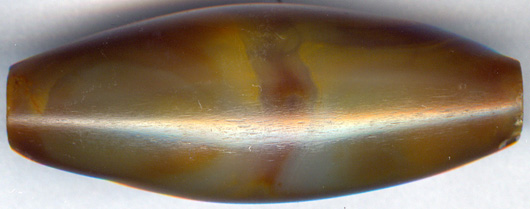
EIV 42 -
44 * 17 mm
Price: 1300 usd
|
At
the level of the Higgs field, the Universe can only
exist precariously balanced on a razor's edge. In this
impossible and ever-flowing point of balance, even the poorest
illiterate Indian might exclaim: "Krishna always triumphs."
Following the narrative arc of every good movie, Vishnu, even as
virtue, invariably wins at the climax and in the most thrilling
contest possible. Only at this point can
Shiva's cosmic,
yet fragile, dance on the razor's edge be re-balanced.
|
|
|
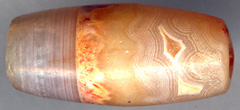
EIV 106 -
18,5
* 8,5 mm
Price: 600 usd
|
Interestingly, two of Vishnu's most renowned incarnations,
Krishna and Rama, both held royal positions. They were kings.
Yet, they were also Kings of War, which in my view makes their
narratives less reflective of the peaceful Indus culture.
However, I interpret them as indicators leading back to the
Indus period, in the sense that these two incarnations were
virtuous royal upholders of social equilibrium.
Pyramids of Power versus Public Baths
The pyramid itself can be seen as an architectural manifestation
of the social stratifications of ancient Egyptian society. Egypt
was a war-oriented and rigidly hierarchical society. In
contrast, the Indus civilization managed to prosper for
approximately
2000 years devoid of wars, violence, and exploitative
elites. Instead of erecting pyramids to serve the imagined
afterlife of a single individual, the Indus people established
cities with 'flat' architecture, with almost no 'outstanding'
structures for private residences. In a city with 'equal'
buildings, it's reasonable to assume that the inhabitants were
also more or less equal. The most significant and prominent
structures were immense water reservoirs that most probably also
served as public baths.
Cities like Mohenjo-daro and Harappa were well planned with a
grid layout of streets and houses, drainage systems, and public
baths, suggesting a highly organized central authority and
potentially equal access to amenities.
I
can't help but perceive these huge public baths as symbolic social
equalizers where people, divested of their usual coverings,
merged in the water as a single entity. Even today, you can
observe the Indian collective ritual adoration of water at the ghats of Varanasi.
The existence of standardized weights and measures across the
civilization could also point towards economic fairness and
control by a central authority, again indicative of an
egalitarian society.
|
|
|
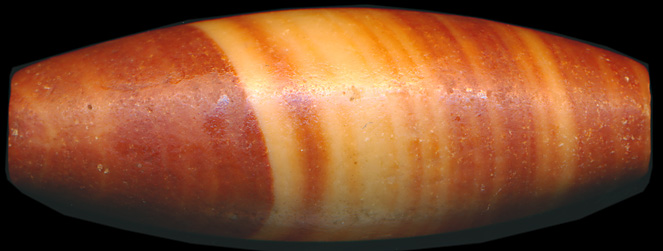
EIV 46 -
42 * 15 mm
Price: 1100 usd
|
In a city marked by 'equal' buildings, it's plausible to
surmise that the inhabitants were largely egalitarian as well.
The most significant and prominent
structures were immense water reservoirs and public baths. I
can't help but perceive these public baths as symbolic social
equalizers where people, divested of their usual coverings,
merged in the water as a single entity. Even today, you can
observe the Indian collective ritual adoration of water at the
ghats of Varanasi.
|
|
|
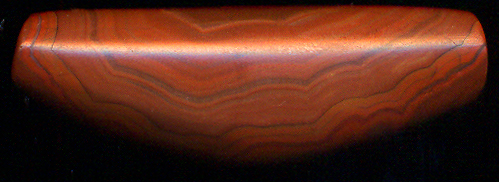
EIV 47 -
40 * 14 * 11 mm
SOLD
|
THE
VIRTOUS LEADER
The Indus civilisation displays a striking lack of
Monumental Architecture: The lack of grand palaces, temples, or
monuments that would typically indicate a hierarchical society
with a powerful elite class is notable in the Indus Valley
Civilization. This could be suggestive of a society without
extreme social divisions.
|
|
|
VARIEGATED
JASPER INDUS BEADS
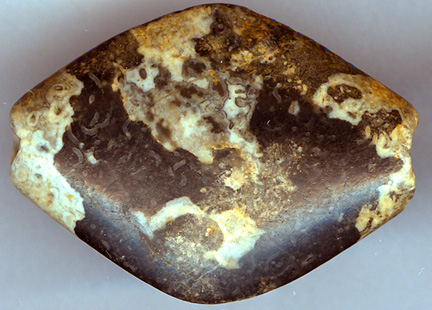
EIV 48 -
35
* 25 * 8 mm
Price: 800 usd
|
The Indus
Elite & the Priest-King
The Indus civilization, however, did not function without an
elite. The so-called "Priest-King" statue from Mohenjo-daro
displays a face of a mature and responsible leader.
Among the most intriguing artifacts unearthed from the
civilization is a small seated figure often referred to as the
"Priest-King." Discovered in Mohenjo-daro, one of the major
urban sites of the Indus civilization, this figure is crafted
from steatite (soapstone) and depicts a bearded man with a
patterned robe draped over one shoulder, adorned with an
intricate trefoil pattern thought to symbolize the "pipal" leaf,
which is regarded as sacred in many Indian traditions. His
half-closed eyes give an impression of deep contemplation or
meditation.

As a scientist, the parameters of empirical evidence
and rigorous methodology would indeed limit me from
definitively asserting that this figure represents a
priest and/or a king. Nevertheless, as someone who
cherishes the power of imagination and the beauty of
speculative thought, I permit myself a certain level of
creative license. This enables me to venture beyond the
strictly factual and to hypothesize about the
possibilities inherent in both this captivating artifact
and the Indus beads.
The statue's dignified demeanor and decorative elements, such as
a central headband ornament and what appears to be an arm
bracelet, could signify status and power. This implies that the
figure might represent a key societal figure, potentially a
priestly and/or regal authority. This artifact is frequently viewed
as proof of a superior social and political stratum in Indus
society, likely an elite class. The semi-closed, introspective
eyes of the "priest-king" evoke thoughts of the Indian third eye
concept, especially when considering the circular centerpiece of
his headband.
|
|
|

EIV 49 -
36 * 12 mm
Price: 1100 usd |
Variegated Jasper and unusual forms of agate
n these rare ancient Indus beads
one will often find what is referred to as variegated
jasper.
As mentioned in the other
section of Indus beads, the
Indus people adored Jasper.
Variegated Jasper was the
favorite gemstone of the Indus and Mesopotamian people.
|
|
The multitude of terra cotta figures, frequently perceived as
goddesses, discovered at Indus sites portray women decked in
refined jewelry and garments, rejecting any idea of an ancient
Indus society without social distinctions. Initial
archaeological digs in the Indus Valley revealed relatively
consistent burial customs, lacking considerable differentiation
in grave goods that could imply social stratification. However,
subsequent excavations have uncovered some diversity in burial
offerings, indicating the potential
presence
of social disparities. Indus burial sites do hint at a
degree of social hierarchy, with women wearing thicker,
utilitarian bangles buried at one extreme, and those with
slender, decorative bangles at the other.
|
|
|
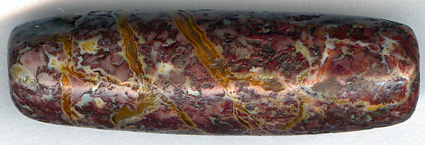
EIV 50 -
35 * 10 mm -
SOLD
|
In this type of Jasper, there are up to 20 percent non-quartz
elements.
These elements account or the wide
range of colors and patterns. In this sense, jasper demonstrates
a larger capacity for variation
than agate. This is clearly shown in the bead to the left.
|
|
Nevertheless,
beyond beadwork, we don't find ostentatiously appointed graves
replete with gold and other extravagant symbols of status,
unlike the grand burial sites of the Egyptian elite. This, to
me, suggests a society far less polarized in terms of wealth and
status compared to its Mesopotamian and Egyptian contemporaries.
|
|
|

EIV 51 -
38 * 11 mm
Price: - SOLD
|
The patterns in agate are as a general rule following harmonious
geometric rules. Jasper beads, on the other hand, are more
unpredictable showing resemblance to abstract modern art. |
|
The virtuous leader walking the talk
"One day at sunrise, after his morning ablution in the waters
of the Saraswati, Srila Vyasadeva sat down to meditate. The
great Sage saw certain anomalies in the fiber of the
millennium... He foresaw that the life of everything material
would be cut short for lack of virtue." - Srimad-Bhagavatam
1.4.15-18 (Bhagavata Purana)
The Srimad-Bhagavatam, also known
as the Bhagavata Purana, is a part of the Mahapuranas, a genre
of ancient Indian scriptures. While the extant text of the
Bhagavata Purana in its current form is generally dated between
the 7th and 10th centuries CE, it is widely believed to carry
forward older oral traditions. In ancient India, knowledge,
including spiritual teachings and philosophical insights, was
typically transmitted orally across generations.
In essence, while the Bhagavata Purana may not be as ancient as
the Indus Valley Civilization, it could indeed be a repository
of much older cultural memories and traditions. Here, the mention of the Saraswati River, which is now
believed to have dried up, offers a historical backdrop and a
point of reflection.
The quote from Srimad-Bhagavatam encapsulates a profound
realization by the sage Srila Vyasadeva. As he meditates by the
Saraswati River—considered a lifeline of the ancient Indus
Valley Civilization—Vyasadeva envisions disruptions in the
normal course of time. This concept of 'anomalies in the fiber
of the millennium' may metaphorically point to an impending
imbalance or calamity.
What's interesting is the cause attributed to this impending
shortening of 'everything material' - the lack of virtue. This
moral insight suggests a prescient understanding of the
interconnectedness of human ethics and the material world's
sustainability. It echoes modern concerns about the role our
collective morality plays in exacerbating or alleviating
environmental crises.
Throughout
India's diverse and intricate history, there have been examples
of leaders who embodied values and ideologies starkly
contrasting the traditional, power-oriented model often found in
leadership roles across the world.
In this context, I propose the idea of an unbroken lineage of
virtuous leadership dating back to the Indus civilization.
Consider Mahatma Gandhi, who is universally lauded for his
philosophy of nonviolent resistance and his unwavering
dedication to achieving social justice and equality. His core
principles of "ahimsa" (non-violence) and "satyagraha" (the
force of truth) catalyzed the Indian National Congress's
struggle for freedom and sparked similar civil rights movements
across the globe. In direct contrast to traditional paradigms of
leadership defined by power and force, Gandhi emphasized moral
authority, simplicity, and self-sacrifice. It's noteworthy that
Gandhi was raised in Gujarat, a region with historical ties to
the Indus Valley Civilization. From childhood, he was influenced
by the local Jain community, and it's plausible that Jainism
itself might be a distant echo of the ethical principles of the
Indus culture.
Going back in time from Ghandi, the first in line to mention is
Emperor
Akbar the
Great,
the ruler of the Mughal Empire from 1556 to 1605. Recognized for
his policy of religious tolerance and dedication to promoting a
syncretic culture, Akbar endeavored to unify his multifaceted
empire through just laws and forward-thinking reforms. His reign
is commonly viewed as a pinnacle in Mughal governance, not
solely because of the empire's geographical expansion, but owing
to the exceptional degree of cultural and religious amalgamation
that took place. Notably, many Hindus view him as a monarch who
gradually adopted more and more elements of Hindu philosophy and
practices, illustrating a convergence of cultural and spiritual
ideologies.
The line of priest-kings
Earlier in Indian history, the Mauryan
Emperor
Ashoka
(reigned c. 268-232 BCE) offers another model of virtuous
leadership. Following a brutal war that resulted in the conquest
of the kingdom of Kalinga, Ashoka had a dramatic change of
heart, renounced violence, and converted to Buddhism. He went on
to become a champion of dharma (righteousness), spreading the
teachings of Buddhism both within and beyond his empire, and
implementing policies aimed at the welfare of his subjects.
The transformative journey of Ashoka into a virtuous leader may
have been unlikely without the legacy of another royal figure,
Prince Siddhartha, who came to be known as the Buddha. In a
timeframe almost concurrent with Buddha's, Lord Mahavira emerged
as the zenith of 24 generations of Tirthankaras, embodying an
ethically enlightened leadership. This concept of virtuous
rulers aligns with our understanding of the priest-king figure
in the Harappan society. All these esteemed leaders were akin to
'priest-kings', merging spiritual guidance with governance,
reminiscent of the speculated model of leadership in the ancient
Indus Valley Civilization.
These leaders, in their respective eras and contexts, showed
that leadership could be practiced in ways that prioritize
empathy, compassion, tolerance, and nonviolence, offering an
alternative to models based on power, domination, and
aggression. They serve as reminders that alternative paradigms
of leadership, rooted in ethical and moral virtues, can and have
existed in history.
|
|
|
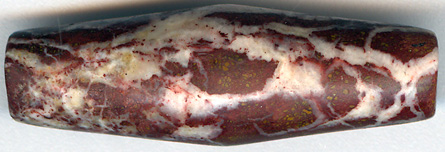
EIV 52 -
37 * 12 mm
Price: 900 usd
|
For me, this ancient jasper bead
with crystalline formations can be viewed as a modern abstract art painting.
These beads are furthermore appealing to the notion of
'individuality.
|
|
|

Let us return to the priest-king.
The half-closed, introspective eyes of the Harappan
"Priest-King" suggest a leader seeking answers within himself.
This figure appears to be as much a sage as a king, with his
modest attire and lack of ostentatious adornment. The tone of a
society is set by its leaders. When leaders are corrupt, their
subjects will invariably follow suit. Conversely, when leaders
are guided by virtue and morality, their example will resonate
to the furthest reaches of their realm, even influencing the
actions of the humblest individuals, such as how a destitute man
treats a dog.
|
|
|

EIV 53 -
36,5 * 10,5 mm
Price: 900 usd
|
Each one stands out as different.
I never have difficulties identifying one of these grand old
Indus beads when I have to find them in my huge collection.
|
|
Societies can be formed and maintained through various means.
Violence and strictly hierarchical religious organizations can
dominate not only through physical control but also through
narratives that instill psychological fear. In our current
Western context, societies can appear to thrive temporarily on
greed, often embodied by multinational corporations.
Yet, there appears to be another cohesive force capable of
shaping and sustaining societies.
This force, I propose, is virtue.
|
|
|

EIV 56 -
33 * 13 mm
Price: 900 usd
|
|
|
JAINISM AND
THE INDUS VALLEY CIVILIZATION
We can begin tracing the lineage of the 24 Jain
Tirthankaras, starting from approximately 600 BC. Typically, 24
generations span roughly a period of 700 years, which aligns
closely with the timeline of the Indus Valley civilization or at
least the preserved collective memory of it. Jainism's
stronghold is in Gujarat, a region where the Indus civilization
flourished for a longer period compared to the west. The first
of the Tirthankaras was named Rishab Dev. Intriguingly, Rishab
Dev is another name for Shiva, the god of meditation in the
Indus tradition.
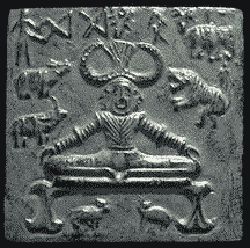
Shiva - Pashupati - sitting in a
meditation
posture controlling the animals ...
around him - and in him
|
|
|

EIV 57
- 38 * 14 * 11,5 mm
Price: 900 usd
|
|
|
In ancient
Indian thought, virtue was closely tied to 'seva',
a Sanskrit term for service. Interestingly, this notion of seva
was not rooted in the subjects' devotional service towards their
King, but rather it was the other way around. A leader was
expected to embody and exemplify righteous living for his
citizens. In essence, they needed to
walk the
'Gandhian' talk.
How then could they counteract the potential risks of greed's
capacity to disrupt the social cohesion of a highly organized
society? The solution lay in leading by example. When the great
Buddhist King Ashoka renounced his vast empire to become a
wandering ascetic, he was merely following an ancient path that
several leaders had trodden before him. Prince Siddhartha did
it, eventually becoming Buddha. The contemporary Jain leader
Mahavira did it as well. Notably, Mahavira was the last of 24
Tirthankaras who made this transformative choice.
|
|
|
|
|
|
|
Overcoming the
potential threat of greed, which can corrode the social fabric
of a highly organized society, necessitates leading by example.
The great Buddhist king Ashoka provides a potent example: he
relinquished his vast empire to live as an ascetic monk,
choosing a humble, wandering life. His transformation followed
an ancient path trodden by many influential figures, such as
Prince Siddhartha, who later became Buddha, and the Jain leader
Mahavira,
the last of the 24
Thirtankaras.
The long earlobes of Buddha serve as a potent symbol: they
signify that he was not just an ordinary beggar but Prince
Siddhartha. His elongated earlobes resulted from the kingly
practice of wearing heavy gold ornaments. When a poor man
renounces the world, may not garner much attention - after all,
what material possessions does he have to renounce? But when a
king steps down from his throne, it reverberates through the
entire society, inspiring profound reflection and
transformation. Can you imagine the societal impact if figures
like Monsanto executives or Donald Trump were spotted as
mendicant monks in the streets of New York? The power of such
renunciation is hard to overstate.
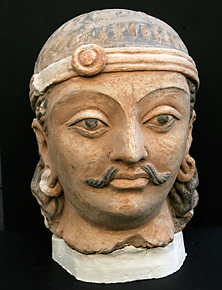

Note the similarity between
this King's head
ornament and that of the Indus Priest-king.
|
|
|

EIV 59
- 37,5 * 10,5 mm
Price: 900 usd
|
|
|
Those with power and wealth have the privilege to choose
the path of renunciation. Indian mythology is replete with tales
extolling kings who abandoned their realms to embrace a life of
asceticism. This time-honored Indian ethos permeated society,
influencing even ordinary men to renounce worldly attachments
once their children had matured and established their own
families.
I would venture to say that this represents virtue in its most
undiluted form.
Let's revisit the contemplative figure of Shiva. In
ancient India, meditation was associated with virtue. It was
believed that virtue had to be nurtured through meditation, and
conversely, that meditation needed to be virtuous. This
association is clearly evident in the passage from the
Srimad-Bhagavatam mentioned earlier. There are numerous myths of
saints amassing great power through their meditative practices,
only to succumb to the temptation of using this power to serve
personal interests rather than dedicating it to the welfare of
all. The prevalence of these stories demonstrates the emphasis
that ancient India placed on virtue—a focus that rivals the most
virtuous chapters of Christian history.
|
|
|

EIV
61
- 39 * 9,5 mm
Price: 700 usd
|
|
|
The mysteries of the ancient Indus Valley civilization
fuel my imagination, especially since its script remains,
thankfully, undeciphered. In the absence of hard facts, I find
myself able to romanticize the Indus culture as an idealized
society compared to our current world, which is marred by stark
social disparities between a minuscule elite and a middle class
that's sliding into oblivion—both metaphorically and quite
literally. I have no issue with wealth itself! However, it's
unfortunate that a large portion of wealthy individuals amassed
their riches not through benevolence, but rather through
unrelenting greed.
|
|
|

EIV
62
- 36 * 9 mm
Price: 900 usd
|
|
|
In the crushing jaws of multinational corporate greed,
smaller states serve as breakfast, while war grows ever more
profitable. I find myself drawn towards the past, scouting for
future possibilities. Our ancient history unfolds a window,
reflecting lofty visions for our future. Among the annals of
history, the Indus Valley Civilization uniquely stands as the
only extensive society that favored alternative conflict
resolution strategies over war and aggression.
|
|
|
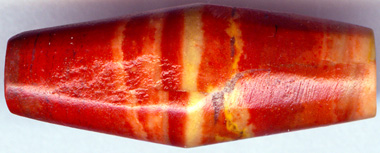
EIV
63
- 31,5 * 12 * 10 mm
Price: 700 usd
|
|
|
In over
a thousand sites excavated thus far, not a trace of war or
any substantial weapons has been discovered. Early
archaeologists, upon their initial findings, were under the
impression they had
stumbled
upon a civilization solely inhabited by children. In India,
the faint vestiges of these peaceful ways can be gleaned from
the life of Mahatma Gandhi and the concept of
ahimsa -
nonviolence embraced by Jains, Hindus, and Buddhists.
In these tumultuous times, marked by rampant corporate greed and
erratic political leadership, could we perhaps discern the
presence of virtuous leadership? In expressing a personal
perspective, I venture to nominate Elon Musk as a figure who, in
spite of controversies, embodies elements of this virtue in his
pursuit of sustainable and humanistic technological advancement.
|
|
|

EIV 64
- 61 * 12,5 mm
Price: 1100 usd
|
|
INDUS
BEADS OF VIRTUE & MEDITATION
The golden age of the
Indus Valley Culture is reflected with profound
brilliance in their exquisite beads. These
ancient artifacts narrate a tale of a culture that
achieved an unparalleled level of refinement and skill,
extending from the grand scope of urban life to the
intricate details of bead crafting. As proficiently as
the Indus people built their immaculate cities, they
also excelled in the art of creating flawless beads. To
me, each Indus bead embodies a potent symbol of peace
and the steadfast belief in equitable wealth
distribution. I regard them as instruments for refining
a form of meditation that cultivates virtue. It's
cooperation, not corporate greed, that moves us closer
to utopian ideals.
You may say that I am a dreamer,
and I won't deny it. But remember, I'm not the only one.
The dawn of new beginnings always starts with dreams.
Yet, in the meta-modern paradigm, we remain fully aware
of our dreams as dreams, and still, we continue to dream
... fully awake.
|
|
|
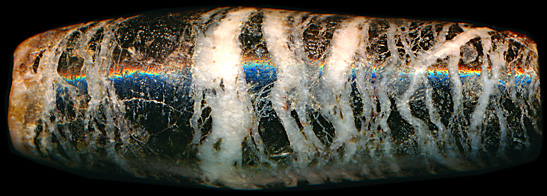
Price: 900 usd
|
|
|
|
|

EIV 107 -
16,5
* 7,5 mm
Price: 500 usd
|
|
|
|
|

EIV 67 -
27 * 10 mm
Price: 600 usd
|
|
|

EIV 68 -
38 * 10 mm
Price: 1100 usd
|
|
|
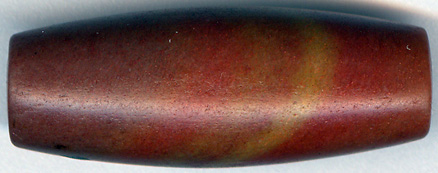
EIV 69 -
36 * 14 mm
Price: 900 usd
|
|
|
|

EIV 70 -
21,5 * 7,5 mm
Price: 500 usd
|
|
|
|
INDUS VALLEY AGATE BEADS

EIV 72 -
44,5 * 26,5 * 7,5 mm
Price: 1500 usd
|
|
|
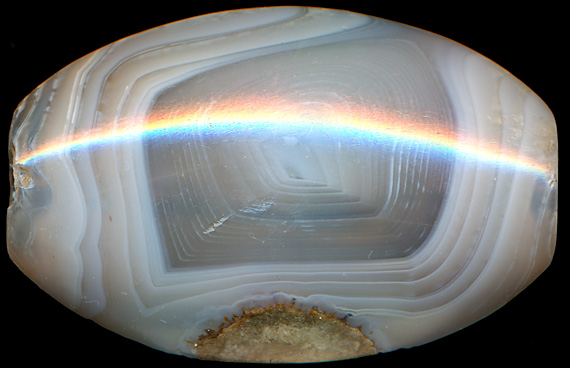
EIV 72A - 36 * 28 * 10 mm
Price: 1700 usd
|
|
|

EIV 72B - 29 * 27 *9 mm
Price: 1500 usd
|
|
|
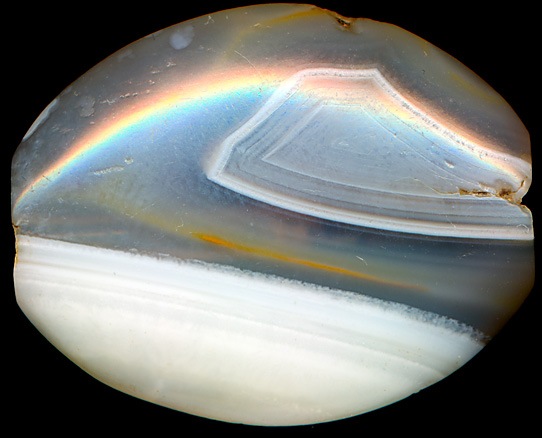
EIV 72C - 34 *
26,5 * 9 mm
Price: 1300 usd
|
|
|
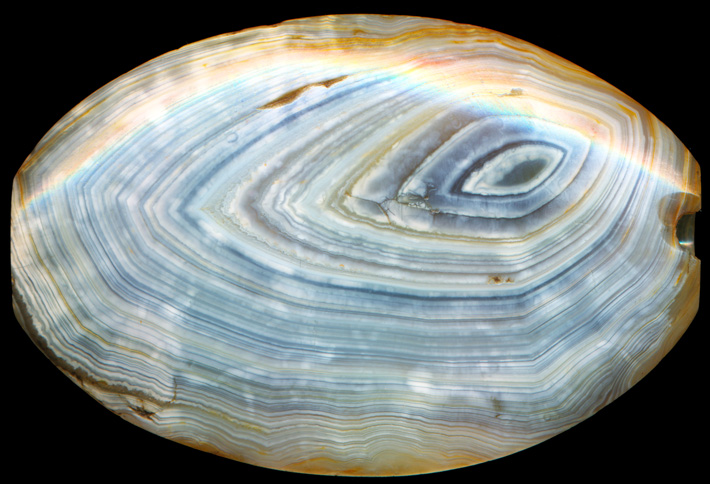
EIV 72D - 45 * 29,5 * 8 mm
Price: 1300 usd
|
|
|

EIV 72E - 33 * 17,5 * 14 mm
Price: 1100 usd
|
|
|
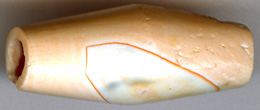
EIV 108 -
20 * 8 mm
Price: 700 usd
|
|
|

EIV 109 -
21 * 7 mm
Price: 700 usd
|
|
|
|
|

EIV 110 -
15
* 6,5 mm
Price: 500 usd
|
|
|
|
|

EIV 111 -
15
* 6 mm
Price: 500 usd
|
|
|
|
|

EIV 77 -
27,5
* 7,5 mm
Yoni-lingam
Price: 1000 |
The watchful third eye is the observer that by virtue of the
observation itself creates order out of chaos.
A human being is as consciousness a manifestation of the highest
order.
This order is the anti-thesis of the third law of
thermodynamics.
|
|
|
|

EIV 112 -
17
* 5,5 mm
Price: SOLD
|
|
|
|
|

EIV 113 -
18
* 6,5 mm - SOLD
|
|
|
|
|

EIV 80
- 37 * 10 * 9 mm
Price: 900 usd
|
|
|
|
|
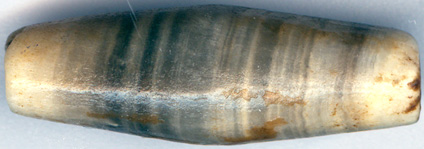
EIV 81
- 35,5 * 11,5 mm
Price: 700 usd
|
|
|
|
|
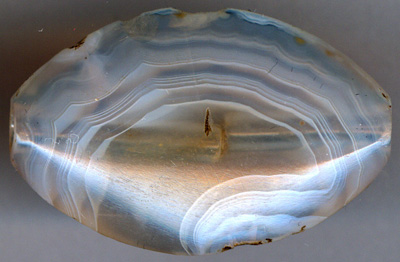
EIV 84 -
42 * 15 mm
Oyster shell formed Indus Bead of immense beauty
SOLD
|
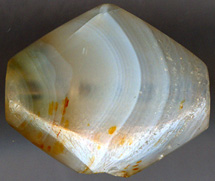
EIV 85 -
42 * 15 mm
|
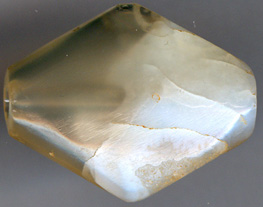
EIV 86 -
21,5
* 17 * 6 mm
|
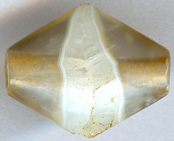
EIV 87 -
42 * 15 mm
|
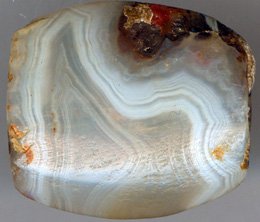
EIV 89 -
21
* 19 * 7 mm
|
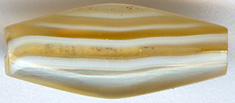
EIV 90 -
19
* 8 * 4 mm
Price: 700 usd
|
|
|
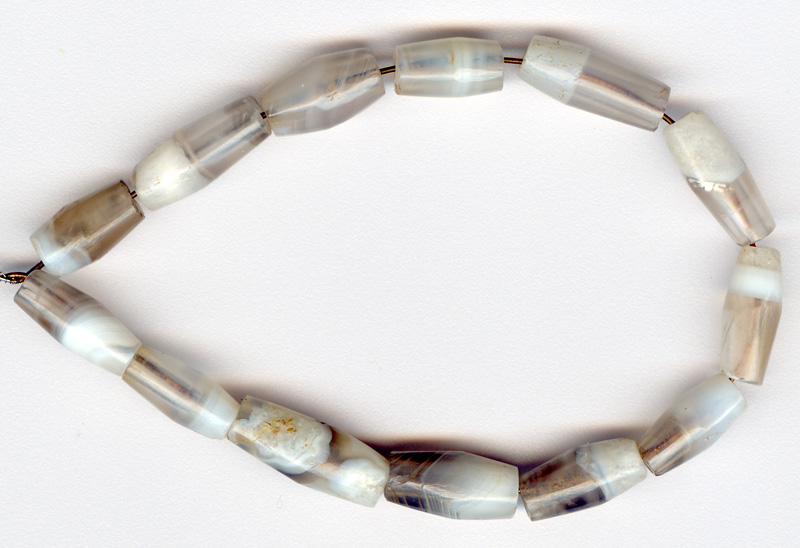
EIV 91 -
11-13
* 5 mm
Price: 1800 usd
|
|
|
|
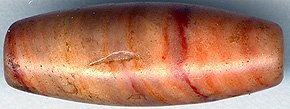
EIV 114 -
23,5
* 9 mm
Price: 700 usd
|
|
|
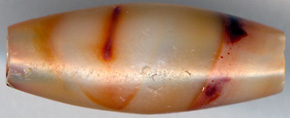
EIV 115 -
24 * 9 mm
Price: 700 usd
|
|
|
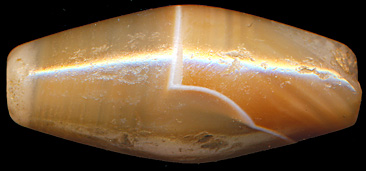
EIV 116 -
23,5
* 10,5 mm
Price: 900 usd
|
|
|

EIV 118 -
22
* 8,5 mm
Price: 800 usd
|
|
|
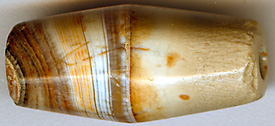
EIV 119 -
22 * 10 mm
Price: 700 usd
|
|
|

4EIV 120 -
23,5
* 7,5 mm
Price: 600 usd
|
|
|

EIV 121
-
22 * 10,5 mm
Price: 500 usd
|
|
|

EIV 122
-
19,5 * 10 mm
Price: 700 usd
|
|
|
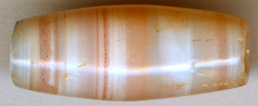
EIV 123 -
20 * 8 mm
Price: 700 usd
|
|
|

EIV 124 -
21,5 * 7 mm
Price: 700 usd
|
|
|

EIV 125 -
18 * 8 mm
Price: 600 usd
|
|
|

EIV 126 -
18,5
* 7 mm
Price: 900 usd
|
|
|

EIV 127 -
14,5
* 6 mm
Price: 500 usd
|
|
|

EIV 128 -
17 * 10,5 * 7 mm
Price: 500 usd
|
|
|
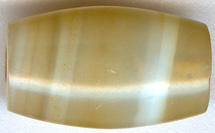
EIV 129 -
17,5
* 10 * 6,5 mm
Price: 800 usd
|
|
|

EIV 130 -
14,5 * 8,5 * 5,5 mm
Price: 600 usd
|
|
|

EIV 131 -
14 * 9 * 7 mm
Price: 700 usd
|
|
|
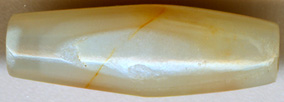
EIV 132 -
23 * 7,5 mm
Price: 500 usd
|
|
|
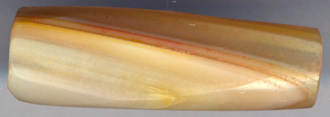
EIV 133 -
26,5
* 8 mm
Price: 450 usd
|
|
|
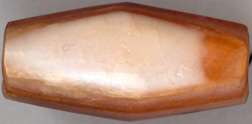
EIV 134 -
21 * 10 mm
Price: 450 usd
|
|
|

EIV 135 -
24,5
* 7 mm
Price: 500 usd
|
|
|

EIV 136 -
24 * 8 mm
Price: 700 usd
|
|
|
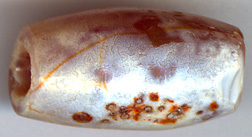
EIV 137 -
19
* 10 mm
Price: 500 usd
|
|
|

EIV 138 -
26,5
* 7 mm
Price: 400 usd
|
|
|

EIV 139 -
30
* 8,5 mm
Price: 1000 usd
|
|
|
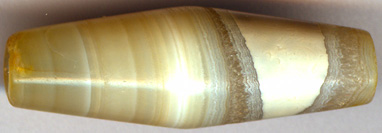
EIV 140 -
31 *
10 mm
Price: 1000 usd
|
|
|

EIV 141 -
32 * 10 mm
Price: 900 usd
|
|
|
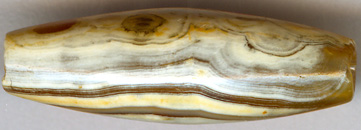
EIV 142
-
30 * 10 mm
Price: 700 usd
|
|
|
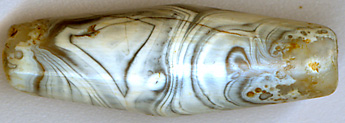
EIV 143 -
28 * 9 mm
Price: 900 usd
|
|
|
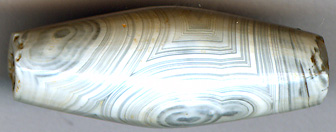
EIV
144
-
27 * 10,5 mm
Price: 900 usd
|
|
|

EIV 145 -
27,5
* 9 mm
Price: 450 usd
|
|
|

EIV 146 - 26
* 8 mm
Price: 900 usd
|
|
|
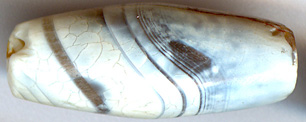
EIV 147 -
24 * 10,5
* 7,5 mm
Price: 500 usd
|
|
|
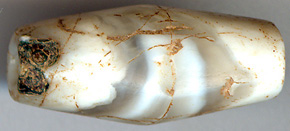
EIV 148 -
22 * 10 mm
Price: 350 usd
|
|
|
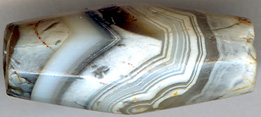
EIV 149
-
22 * 9 mm
Price: 350 usd
|
|
|
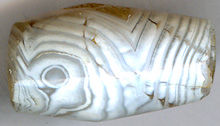
EIV
150
-
27 * 10 mm
Price: 350 usd
|
|
|
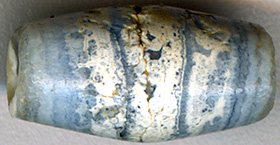
EIV 151 -
14,5
* 7,5 mm - Rare blue color
Price: 700 usd
|
|
|

EIV 152
-
20 * 8,5 mm
Price: 500 usd
|
|
|

EIV 153 -
15
* 7,5 mm
Price: 500 usd
|
|
|

EIV 154 -
15
* 7 mm
Price: 500 usd
|
|
|

EIV 155 -
21 * 7,5 mm
Price: 500 usd
|
|
|
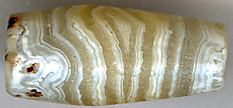
EIV
156
-
19 * 8,5 mm
Price: 500 usd
|
|
|

EIV 157
-
20 * 8,5 mm
Price: 500 usd
|
|
|

EIV 158 -
44
* 11 mm
Price: 1500 usd
|
|
|
|

EIV 159
- 40;5 * 12 mm
Price: 900 usd
|
|
|
|
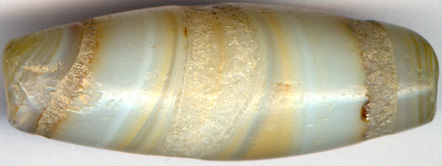
EIV 160 -
37,5
* 18,5 mm
Price: 900 usd
|
|
|
|

EIV 161 -
37 * 11,5 mm
Price: 500 usd
|
|
|
|

EIV 162 -
34
* 14 mm
Price: 700 usd
|
|
|
|
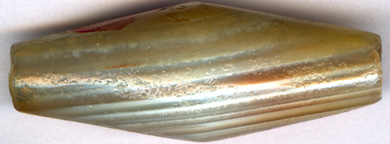
EIV 163 -
40,5
* 15 mm
Price: 700 usd
|
|
|
|

EIV 164 -
39 * 8
* 9,5 mm
Price: 900 usd
|
|
|

EIV 165 -
35
* 13,5 mm
Price: 700 usd
|
|
|
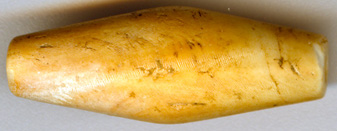
EIV 166 -
26,5
* 9,5 mm
Price: 500 usd
|
|
|

EIV 167 -
27,5
* 8 mm
Price: 500 usd
|
SUPER ANCIENT BANDED LIMESTONE BEADS
In the early days of the Indus Valley civilization,
crafting an agate bead was a monumental task. The sheer
complexity of drilling and shaping these beads is alone a cause
for admiration, especially when we consider the long bicone and
slender agate beads crafted during this era. However, a much
more easily accessible and manageable material for bead-making
was banded limestone.
Limestone is a sedimentary rock, primarily composed of varying
crystal forms of calcium carbonate, known as calcite and
aragonite. Its hardness on the Mohs scale ranges between 3 and
4, significantly softer than agate or jasper.
It's logical to assume that the ancient Indus people selected
the hardest types of limestone for their bead-making endeavors.
However, despite their careful selection, the relative softness
of the stone coupled with the large holes drilled into them
rendered these beads extremely delicate and vulnerable. This
combination of softness and large hole size made the beads
highly susceptible to the wear and tear of time. As a result,
only a handful of these fascinating artifacts have survived to
our era.
|
|
|

EIV 168 - 30
* 7,5 mm
|
|
|
The bead showcased above is my personal favorite among
the limestone specimens. Its banding is remarkably
beautiful, displaying typical limestone colors. Despite
its structure, where the hole's volume exceeds that of
the stone itself, this bead is in perfect condition.
This bead is indeed a survivor, standing tall against
all odds! I would only part with it for someone who has
walked a similar path, someone who has defied the odds
in their own life. Its new owner should appreciate not
just the beauty, but also the resilience this artifact
embodies.
|
|
|
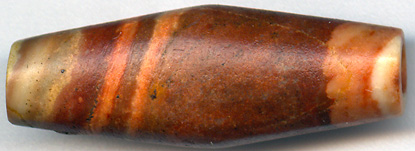
EIV 169 -
33,5 * 11 mm
Price: 1200 usd
|
Yellow brown
banded
limestone -
most probably from
the Pachcham
formation |
|
The banded limestone used in these outstanding ancient
beads was most probably sourced from Gujarat:
Banded limestone is another rock that was transported
from its source in Gujarat to Harappan Sites deep within
the Indus Valley. The particular variety I am referring
to occurs in the Pachcham formation - a zone of Jurassic
sedimentary rock exposed on several islands on the
southern edge of the Great Rann of Kachch. Dholavira,
which is located on Khadir island, was largely
constructed of blocks and slabs composed of this
distinctive yellow-brown banded, sand-textured
limestone.
The Important Stone and Metal resources of Gujarat
during the Harappan Period. Randall Law

|
|
|

EIV 170 -
42,5 * 13 mm
Price: 1200 usd
|
|
The Indus
limestone beads may lack the mesmerizing luster of agate or
jasper beads, but they hold their own unique, subtler kind of
magic. The patterns in limestone beads differ from those in
other bead materials. They adhere to a different set of
'sedimentary mathematics', as is observable in the bead above.
|
|
|

EIV 171 -
39 * 11
mm
Price: 1200 usd
|
Moreover, these
beads offer a diverse color palette, distinct from other bead
materials. For the individual attuned to the nuances of color,
an ancient limestone bead might capture their fascination even
more than the more visually dramatic agate and jasper beads.
They exude a more quiet and understated charm, yet just as
alluring and captivating in their own right. Their beauty lies
in their subtlety and their testament to an ancient and
harmonious civilization that thrived on cooperation and virtue.
|
|
|
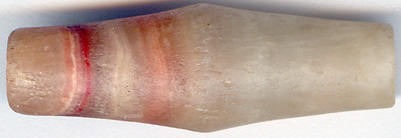
EIV 172 -
33 * 10 mm
Price: 1000 usd
|
|
|

EIV 173 -
37,5
* 12,5 mm
Price: 1200 usd
|
|
|

EIV 174 -
36
* 11 mm
Price: 1000 usd
|
|
|

EIV 176 -
32
* 9 mm
Price: 700 usd
|
|
|

EIV 177 -
24 * 8,5 mm
Price: 700 usd
|
|
|
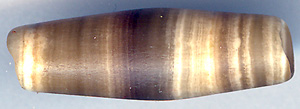
EIV 178 -
23 * 8,5 mm
Price: 700 usd
|
|
|

EIV 179 -
25
* 9 mm
Price: 600 usd
|
|
|
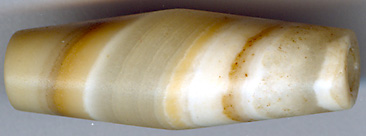
EIV 180 -
30 * 10 mm
Price: 900 usd
|
|
|
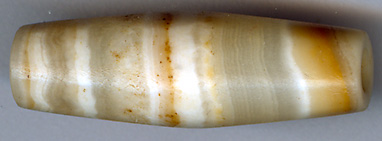
EIV 181 -
30
* 9,5 mm
Price: 900 usd
|
|
|

EIV 183 -
27
* 10,5 mm
Price: 700 usd
|
|
|

EIV 184 -
26 * 8 mm
Price: 700 usd
|
|
|

EIV 185 -
25 * 8,5 mm
Price: 600 usd
|
|
|

EIV 186
-
25,5 *
8
mm
Price: 900 usd
|
|
|

EIV 187 -
22,5 * 8 * 7 mm
Price: 700 usd
|
|
|
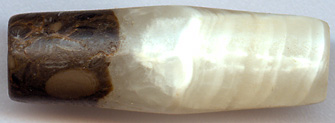
EIV 188 -
27 * 9 mm
Price: 800 usd
|
|
|

EIV 189 -
26 * 9 mm
Price: 800 usd
|
|
|

EIV 190 -
27 * 10 mm
Price: 700 usd
|
|
|
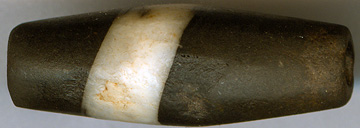
EIV 191 -
27 * 10 mm
Price: 700 usd
|
|
|

EIV 192 -
28 * 10 mm
Price: 700 usd
|
|
|

EIV 193 -
29 * 10 mm
Price: 700 usd
|
|
|
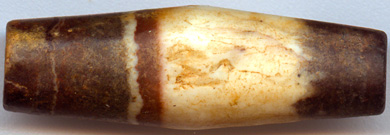
EIV 194 -
33 * 9.5 mm
Price: 700 usd
|
|
|

EIV 195 -
22,5 * 8 mm
Price: 700 usd
|
|
|

EIV 196 -
19
* 8 mm
Price: 500 usd
|
|
|

EIV 197 -
18,5
* 8 mm
Price: 500 usd
|
|
|

EIV 198 -
14,5
* 7 mm
Price: 300 usd
|
|
|

EIV 199 -
15
* 6 mm
Price: 300 usd
|
|
|

EIV 200 -
17
* 6 mm
Price: 300 usd
|
|
|

EIV 201 -
20
* 5 mm
Price: 700 usd
|
|
|
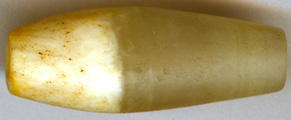
EIV 202 -
29
* 8 mm
Price: 500 usd
|
|
|

EIV 203 -
19,5
* 8,5 mm
Price: 400 usd
|
|
|
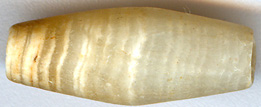
EIV 204 -
21
* 8 mm
Price: 400 usd
|
|
|

EIV 204A -
25,5 * 8 mm
Price: 600 usd
|
|
|

EIV 205 -
39
* 11 mm
Price: 900 usd
|
|
|

EIV 206 -
73,5
* 12 mm
Price: 1500 usd
|
|
|

EIV
207
- 34 * 29 * 8,5 mm
Price: 1300 usd
|
|
|
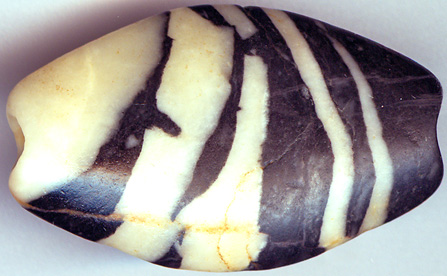
EIV
208
- 37 * 27,5 * 8 mm
Price: 1200 usd
|
LONG CYLINDER BEADS FROM THE EARLY INDUS VALLEY
CIVILIZATION
Presented below is a
selection of beads originating from the ancient segments of the Indus
Valley civilization, likely locations within present-day Pakistan such
as Harappa. A key feature to observe is the significantly larger
perforations in comparison to those in the previous set. These pieces
are crafted from Amazonite, a type of green feldspar. The source of this
semi-precious stone is thought to be either Gujarat or Orissa. It's
important to note that within the context of Indus beadwork, Amazonite
specimens are a rare find.
|
|
|
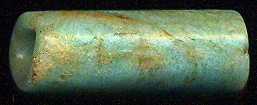
EIV-GT 1
- 18 * 7
mm
Price: 600 usd
|
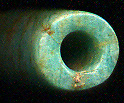 |
|
|
|
|

EIV-GT 2
- 18
* 8 mm
Price: 600 usd
|
 |
|
|
|
|
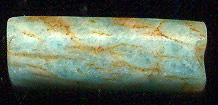
EIV-GT 3 - 16 * 6 mm
Price: 600 usd
|
 |
|
|
|
|

EIV- GT 4
-
Price: 600 usd
|
 |
|
|
Elongated
Cylinder
Carnelian Beads
|
|
|

EIV-T 1 - 29 * 7 mm
Price: 600 usd
|
 |
|
|
|
|
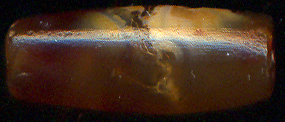
EIV-T 2 - 20 * 8 mm
Price: 600 usd
|
 |
|
|
|
|

EIV-T 3 - 25 * 8 mm
Price: 600 usd
|
 |
|
|
|
|

EIV-T 4 - 20 * 7 mm
Price: 500 usd
|
 |
|
|
|
|

EIV-T 5 - 19 * 7 mm
Price: 500 usd
|
 |
|
|
|
|

EIV-T 6 - 20 * 8 mm
Price: 600 usd
|
 |
|
|
|
|
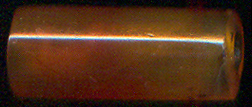
EIV-T 7 - 18 * 8 mm
Price: 600 usd
|
 |
|
|
|
|
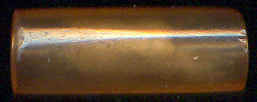
EIV-T 8 - 20 * 7 mm
Price: 600 usd
|
 |
|
|
|
|
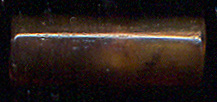
EIV- T 9 - 16 *
5,5 mm
Price: 500 usd
|
 |
|
|
|
|
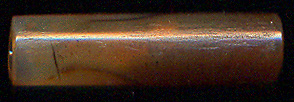
EIV-T 10 - 23 *
6 mm
Price: 600 usd
|
 |
|
|
|
|
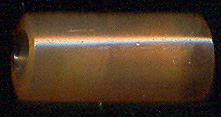
EIV- T
11 - 15 *
7 mm
Price: 500 usd
|
 |
|
|
|
|

EIV-T 12 - 14 *
7 mm
Price: 500 usd
|
 |
|
|
|
|

EIV-T 13 - 14 * 5,5 mm
Price: 500 usd
|
 |
|
|
|
Strange Indus Valley Terra Cotta Eye Bead |
|
|
|
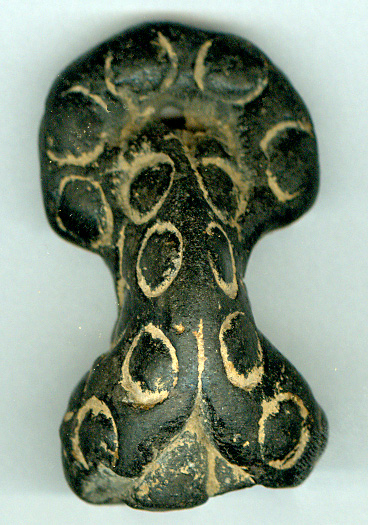
EIV-OIV 1 - 40 * 25 * 21 mm
Price: 2000 usd
|
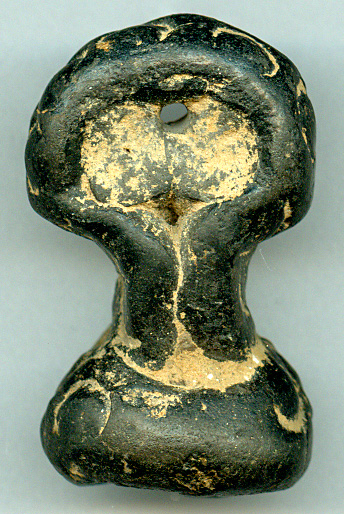
Click on picture for larger image |
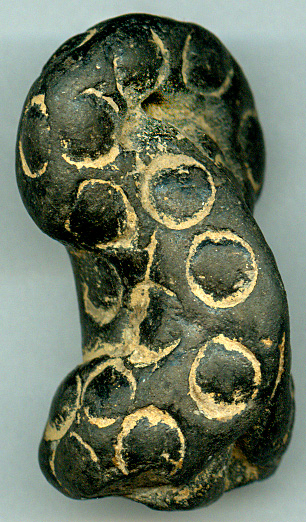
|
|
|
An absolutely unique and very strange jet
stone cobra snake Eye Bead.
Origin: Indus Valley Haryana - Greater India
Read about Eye Beads here
Bead from Mohenjo Daro
|

EIV-TBA 16 - 17 * 5 mm
-
SOLD
|

|
What a
masterpiece this little bead is!
There is more hole than bead stone. This bead was
found by my friend Professor Bhandari when he as a young boy,
before partition 1947 together with his school class was
visiting Mohenjo Daro |
|
|
Here you can see the bead in high resolution:
Picture 1
-
Hole
Indus Valey Eye seal Beads |
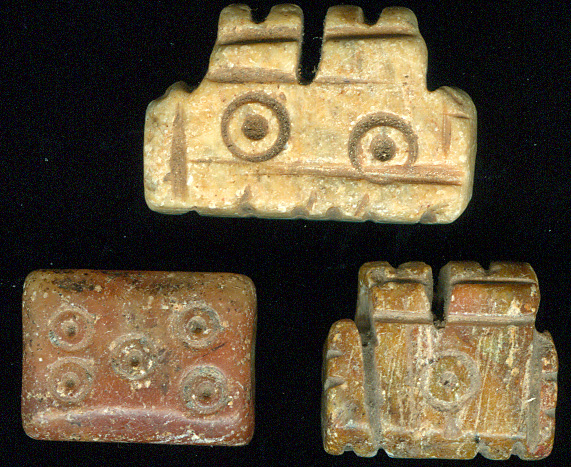
EIV-OIV 2
|

Click on picture for larger image |
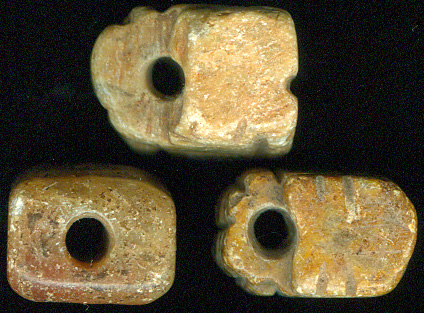
|
|
| |
|
|
|
|
Here is a small display of Indus Valley carnelian beads. You can
find more of these in the
Carnelian bead section.
|
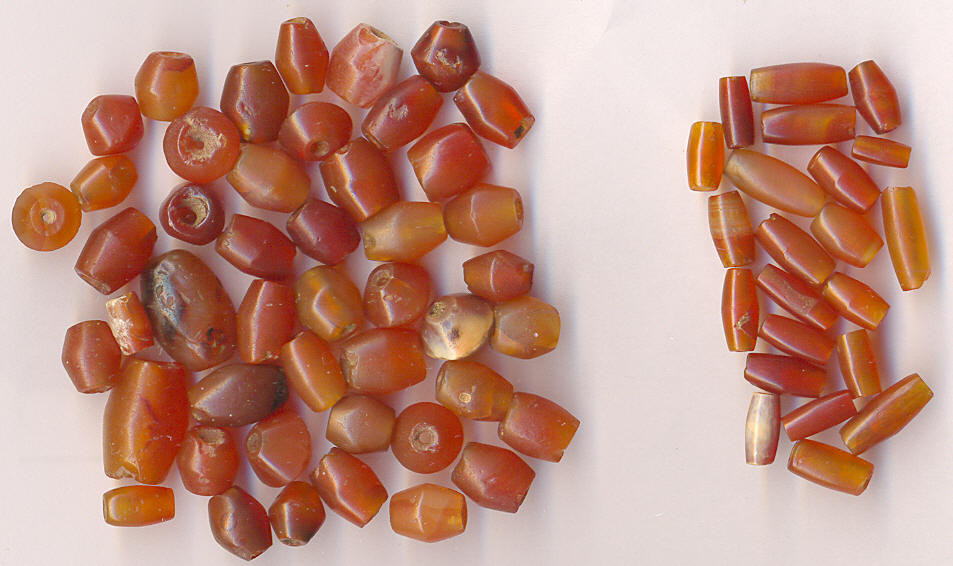
EIV-OIV 15
-
Largest: 16 * 10 mm - : 8 * 6 mm
|
|
|
|
|
|
|
|